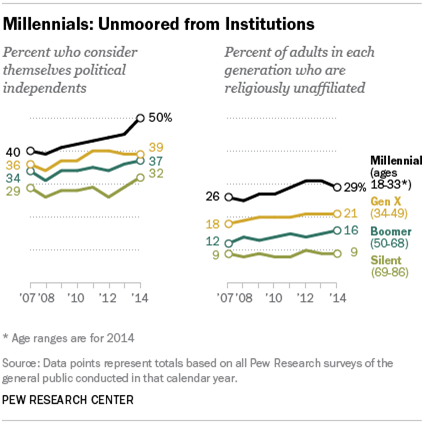 The Millennial generation is forging a distinctive path into adulthood. Now ranging in age from 18 to 331, they are relatively unattached to organized politics and religion, linked by social media, burdened by debt, distrustful of people, in no rush to marry— and optimistic about the future.
The Millennial generation is forging a distinctive path into adulthood. Now ranging in age from 18 to 331, they are relatively unattached to organized politics and religion, linked by social media, burdened by debt, distrustful of people, in no rush to marry— and optimistic about the future.
They are also America’s most racially diverse generation. In all of these dimensions, they are different from today’s older generations. And in many, they are also different from older adults back when they were the age Millennials are now.
Pew Research Center surveys show that half of Millennials (50%) now describe themselves as political independents and about three-in-ten (29%) say they are not affiliated with any religion. These are at or near the highest levels of political and religious disaffiliation recorded for any generation in the quarter-century that the Pew Research Center has been polling on these topics.
At the same time, however, Millennials stand out for voting heavily Democratic and for liberal views on many political and social issues, ranging from a belief in an activist government to support for same-sex marriage and marijuana legalization. (For more on these views, see Chapters 1 and 2.)
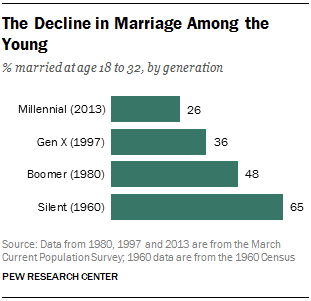 These findings are based on a new Pew Research Center survey conducted
These findings are based on a new Pew Research Center survey conducted
Feb. 14-23, 2014 among 1,821 adults nationwide, including 617 Millennial adults, and analysis of other Pew Research Center surveys conducted between 1990 and 2014.
Millennials have also been keeping their distance from another core institution of society—marriage. Just 26% of this generation is married. When they were the age that Millennials are now, 36% of Generation X, 48% of Baby Boomers and 65% of the members of the Silent Generation were married. (See box on page 10 for demographic portraits of America’s four adult generations). Most unmarried Millennials (69%) say they would like to marry, but many, especially those with lower levels of income and education, lack what they deem to be a necessary prerequisite—a solid economic foundation.2
Digital Natives
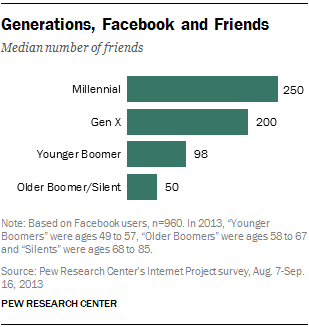 Adults of all ages have become less attached to political and religious institutions in the past decade, but Millennials are at the leading edge of this social phenomenon. They have also taken the lead in seizing on the new platforms of the digital era—the internet, mobile technology, social media—to construct personalized networks of friends, colleagues and affinity groups.3
Adults of all ages have become less attached to political and religious institutions in the past decade, but Millennials are at the leading edge of this social phenomenon. They have also taken the lead in seizing on the new platforms of the digital era—the internet, mobile technology, social media—to construct personalized networks of friends, colleagues and affinity groups.3
They are “digital natives”—the only generation for which these new technologies are not something they’ve had to adapt to. Not surprisingly, they are the most avid users. For example, 81% of Millennials are on Facebook, where their generation’s median friend count is 250, far higher than that of older age groups (these digital generation gaps have narrowed somewhat in recent years).
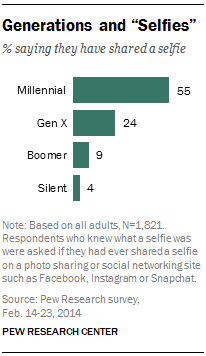 Millennials are also distinctive in how they place themselves at the center of self-created digital networks. Fully 55% have posted a “selfie” on a social media site; no other generation is nearly as inclined to do this. Indeed, in the new Pew Research survey, only about six-in-ten Boomers and about a third of Silents say they know what a “selfie” (a photo taken of oneself) is—though the term had acquired enough cachet to be declared the Oxford Dictionaries “word of the year” in 2013.4
Millennials are also distinctive in how they place themselves at the center of self-created digital networks. Fully 55% have posted a “selfie” on a social media site; no other generation is nearly as inclined to do this. Indeed, in the new Pew Research survey, only about six-in-ten Boomers and about a third of Silents say they know what a “selfie” (a photo taken of oneself) is—though the term had acquired enough cachet to be declared the Oxford Dictionaries “word of the year” in 2013.4
However, amidst their fervent embrace of all things digital, nine-in-ten Millennials say people generally share too much information about themselves online, a view held by similarly lopsided proportions of all older generations.
Racial Diversity
Millennials are the most racially diverse generation in American history, a trend driven by the large wave of Hispanic and Asian immigrants who have been coming to the U.S. for the past half century, and whose U.S.-born children are now aging into adulthood. In this realm, Millennials are a transitional generation. Some 43% of Millennial adults are non-white, the highest share of any generation. About half of newborns in America today are non-white, and the Census Bureau projects that the full U.S. population will be majority non-white sometime around 2043.
The racial makeup of today’s young adults is one of the key factors in explaining their political liberalism. But it is not the only factor. Across a range of political and ideological measures, white Millennials, while less liberal than the non-whites of their generation, are more liberal than the whites in older generations.
Low on Social Trust; Upbeat about the Nation’s Future
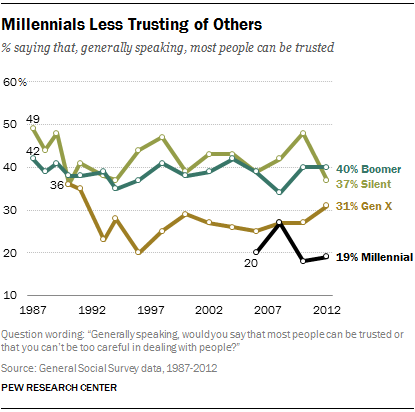 Millennials have emerged into adulthood with low levels of social trust. In response to a long-standing social science survey question, “Generally speaking, would you say that most people can be trusted or that you can’t be too careful in dealing with people,” just 19% of Millennials say most people can be trusted, compared with 31% of Gen Xers, 37% of Silents and 40% of Boomers.
Millennials have emerged into adulthood with low levels of social trust. In response to a long-standing social science survey question, “Generally speaking, would you say that most people can be trusted or that you can’t be too careful in dealing with people,” just 19% of Millennials say most people can be trusted, compared with 31% of Gen Xers, 37% of Silents and 40% of Boomers.
Their racial diversity may partly explain Millennials’ low levels of social trust. A 2007 Pew Research Center analysis found that minorities and low-income adults had lower levels of social trust than other groups.5 Based on similar findings over many years from other surveys, sociologists have theorized that people who feel vulnerable or disadvantaged for whatever reason find it riskier to trust because they’re less well-fortified to deal with the consequences of misplaced trust.6
Despite this distrust of people and detachment from traditional institutions, Millennials are not out of step with older adults when it comes to their views about big business and the role of government. They are about as likely as their elders to have a favorable view of business, and they are more likely than older generations to say they support an activist government.
They are also somewhat more upbeat than older adults about America’s future, with 49% of Millennials saying the country’s best years are ahead, a view held by 42% of Gen Xers, 44% of Boomers and 39% of Silents.7
The relative optimism of today’s young adults stands in contrast to the views of Boomers when they were about the same age as Millennials are now. In a 1974 Gallup survey, only about half of adults under the age of 30 said they had “quite a lot” of confidence in America’s future, compared with seven-in-ten of those ages 30 and older.8
Boomers came of age in the late 1960s and 1970s, helping to lead the civil rights, women’s rights, anti-war and counter-cultural movements of that turbulent era. In 1972, the first presidential election in which large numbers of Boomers were eligible to vote, they skewed much more Democratic than their elders. But attitudes formed in early adulthood don’t always stay fixed. In the latest Pew Research survey, about half of all Boomers (53%) say their political views have grown more conservative as they have aged, while just 35% say they have grown more liberal.
Economic Hardships
Millennials are also the first in the modern era to have higher levels of student loan debt, poverty and unemployment, and lower levels of wealth and personal income than their two immediate predecessor generations (Gen Xers and Boomers) had at the same stage of their life cycles.9
Their difficult economic circumstances in part reflect the impact of the Great Recession (2007-2009) and in part the longer-term effects of globalization and rapid technological change on the American workforce. Median household income in the U.S. today remains below its 1999 peak, the longest stretch of stagnation in the modern era, and during that time income and wealth gaps have widened.
The timing of these macro-economic trends has been especially hard on older Millennials, many of whom were just entering the workforce in 2007 when the economy sank into a deep recession from which it has yet to fully recover.
 Not surprisingly, the new Pew Research survey finds that about seven-in-ten Americans, spanning all generations, say that today’s young adults face more economic challenges than their elders did when they were first starting out.
Not surprisingly, the new Pew Research survey finds that about seven-in-ten Americans, spanning all generations, say that today’s young adults face more economic challenges than their elders did when they were first starting out.
At the same time, fully a third of older Millennials (ages 26 to 33) have a four-year college degree or more—making them the best-educated cohort of young adults in American history. Educational attainment is highly correlated with economic success, even more so for this generation than previous ones. In an increasingly knowledge-based economy, young adults today who do not advance beyond high school have been paying a much stiffer penalty—in terms of low wages and high unemployment—than their counterparts did one and two generations ago.10
However, the new generation of college graduates also have their own economic burdens. They are entering adulthood with record levels of student debt: Two-thirds of recent bachelor’s degree recipients have outstanding student loans, with an average debt of about $27,000. Two decades ago, only half of recent graduates had college debt, and the average was $15,000.11
The economic hardships of young adults may be one reason that so many have been slow to marry. The median age at first marriage is now the highest in modern history—29 for men and 27 for women. In contrast to the patterns of the past, when adults in all socio-economic groups married at roughly the same rate, marriage today is more prevalent among those with higher incomes and more education.
Perhaps because of their slow journey to marriage, Millennials lead all generations in the share of out-of-wedlock births. In 2012, 47% of births to women in the Millennial generation were non-marital, compared with 21% among older women. Some of this gap reflects a lifecycle effect—older women have always been less likely to give birth outside of marriage. But the gap is also driven by a shift in behaviors in recent decades. In 1996, when Gen Xers were about the same age that Millennials were in 2012, just 35% of births to that generation’s mothers were outside of marriage (compared with 15% among older women in 1996).12
Millennials join their elders in disapproving of this trend. About six-in-ten adults in all four generations say that more children being raised by a single parent is bad for society; this is the most negative evaluation by the public of any of the changes in family structure tested in the Pew Research survey (see Chapter 3).
Economic Optimism; Social Security Worries
 Despite their financial burdens, Millennials are the nation’s most stubborn economic optimists. More than eight-in-ten say they either currently have enough money to lead the lives they want (32%) or expect to in the future (53%). No other cohort of adults is nearly as confident, though when Gen Xers were the age Millennials are now, they were equally upbeat about their own economic futures. Some of this optimism, therefore, may simply reflect the timeless confidence of youth.
Despite their financial burdens, Millennials are the nation’s most stubborn economic optimists. More than eight-in-ten say they either currently have enough money to lead the lives they want (32%) or expect to in the future (53%). No other cohort of adults is nearly as confident, though when Gen Xers were the age Millennials are now, they were equally upbeat about their own economic futures. Some of this optimism, therefore, may simply reflect the timeless confidence of youth.
The confidence of Millennials in their long-term economic prospects is even more notable in light of another finding from the latest Pew Research survey: Fully half of Millennials (51%) say they do not believe there will be any money for them in the Social Security system by the time they are ready to retire, and an additional 39% say the system will only be able to provide them with retirement benefits at reduced levels. Just 6% expect to receive Social Security benefits at levels enjoyed by current retirees.
About six-in-ten Millennials (61%) oppose benefit cuts as a way to address the long-term funding problems of Social Security, a view held by about seven-in-ten older adults. There is a much bigger generation gap, however, on the question of whether government should give higher priority to programs that benefit the young or the old. About half (53%) of Millennials say the young, compared with 36% of Gen Xers and just 28% each of Boomers and Silents.
Millennials Are Independent, But Vote Democratic
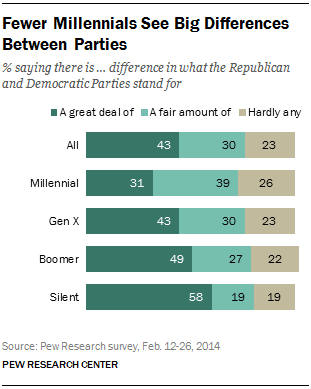 Not only do half of all Millennials choose not to identify with either political party, just 31% say there is a great deal of difference between the Republican and Democratic parties. More people in older generations, including 58% of Silents, say there are big differences between the parties.
Not only do half of all Millennials choose not to identify with either political party, just 31% say there is a great deal of difference between the Republican and Democratic parties. More people in older generations, including 58% of Silents, say there are big differences between the parties.
Even so, this generation stood out in the past two presidential elections as strikingly Democratic. According to national exit polls, the young-old partisan voting gaps in 2008 and 2012 were among the largest in the modern era, with Millennials far more supportive than older generations of Barack Obama. As Obama’s approval ratings have declined in recent years, however, Millennials have joined older adults in lowering their assessments of the president.
Yet Millennials continue to view the Democratic Party more favorably than the Republican Party. And Millennials today are still the only generation in which liberals are not significantly outnumbered by conservatives.

Social and Religious Views
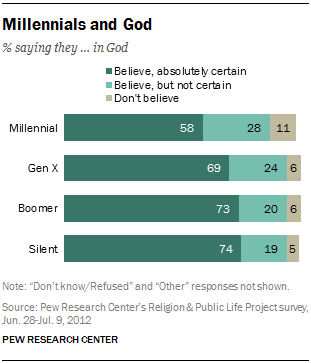 Millennials’ liberalism is apparent in their views on a range of social issues such as same-sex marriage, interracial marriage and marijuana legalization. In all of these realms, they are more liberal than their elders. However, on some other social issues—including abortion and gun control—the views of Millennials are not much different from those of older adults.
Millennials’ liberalism is apparent in their views on a range of social issues such as same-sex marriage, interracial marriage and marijuana legalization. In all of these realms, they are more liberal than their elders. However, on some other social issues—including abortion and gun control—the views of Millennials are not much different from those of older adults.
This generation’s religious views and behaviors are quite different from older age groups. Not only are they less likely than older generations to be affiliated with any religion, they are also less likely to say they believe in God. A solid majority still do—86%—but only 58% say they are “absolutely certain” that God exists, a lower share than among older adults, according to a 2012 survey by the Pew Research Center’s Religion & Public Life Project. But if past is prologue, these young adults may develop a stronger belief in God over the course of their lives, just as previous generations have.
Self-Identification
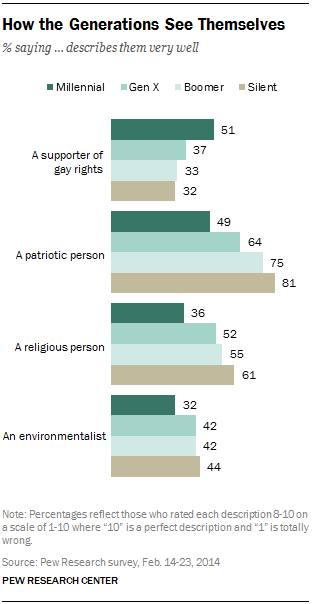 In response to a battery of questions in the latest Pew Research survey about how they think of themselves, Millennials are much less inclined than older adults to self-identify as either religious or patriotic.
In response to a battery of questions in the latest Pew Research survey about how they think of themselves, Millennials are much less inclined than older adults to self-identify as either religious or patriotic.
For example, only about half (49%) of Millennials say the phrase “a patriotic person” describes them very well—with 35% saying this is a “perfect” description.13 By contrast, 64% of Gen Xers, 75% of Boomers and 81% of Silents say this describes them very well. This gap may be due more to their age and stage in life than a characteristic of their generation. When Gen Xers were young, they too lagged behind their elders on this measure in a similarly worded question.14
Millennials are also somewhat less likely than older adults to describe themselves as environmentalists—just 32% say this describes them very well, compared with at least four-in-ten among all older generations.
On the other hand, they are far more likely to say they are supporters of gay rights—some 51% do so, compared with 37% of Gen Xers and about a third of older adults.
Millennials by Age and Race
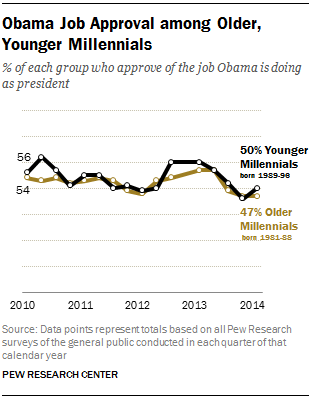 As is the case within any generation, Millennials are not all alike. They are a diverse group with a myriad of views on many of the important issues of their time. Cultural arbiters have yet to determine how young the youngest Millennials are, or when the next generation begins. And some political analysts have suggested that older and younger Millennials may differ in terms of their political views and party allegiances.
As is the case within any generation, Millennials are not all alike. They are a diverse group with a myriad of views on many of the important issues of their time. Cultural arbiters have yet to determine how young the youngest Millennials are, or when the next generation begins. And some political analysts have suggested that older and younger Millennials may differ in terms of their political views and party allegiances.
But an analysis of Pew Research surveys conducted in 2014 shows that the shares of younger and older Millennials who identify with the Democratic Party are roughly comparable.
Younger and older Millennials also have similar assessments of the job Barack Obama is doing as president. According to Pew Research surveys taken in 2014, 50% of younger Millennials (ages 18 to 25) and 47% of older Millennials (26 to 33) approve of the way Obama is handling his job as president.
The political views of Millennials differ significantly across racial and ethnic lines. About half of white Millennials (51%) say they are political independents. The remainder divide between the Republican (24%) and Democratic (19%) parties. Among non-white Millennials, about as many (47%) say they are independent. But nearly twice as many (37%) identify as Democrats while just 9% identify as Republicans.
These partisan patterns are closely linked to views of Obama. While Millennials as a group are somewhat more approving of Obama than Gen Xers, Boomers or Silents, these differences are driven more by race and ethnicity than by age. White Millennials’ views of Obama are not substantially different from those of older whites. Some 34% of white Millennials approve of the job Obama is doing as president, compared with 33% of Gen Xers, 37% of Boomers and 28% of Silents. By contrast 67% of non-white Millennials give Obama high marks for the job he’s doing as president.
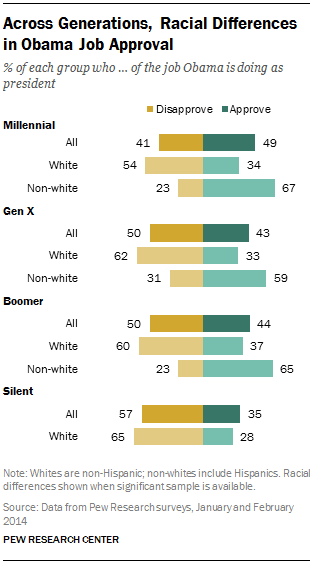 White and non-white Millennials have different views on the role of government as well. On balance, white Millennials say they would prefer a smaller government that provides fewer services (52%), rather than a bigger government that provides more services (39%). Non-white Millennials lean heavily toward a bigger government: 71% say they would prefer a bigger government that provides more services, while only 21% say they would prefer a smaller government. The racial gaps are about as wide among Gen Xers and Boomers.
White and non-white Millennials have different views on the role of government as well. On balance, white Millennials say they would prefer a smaller government that provides fewer services (52%), rather than a bigger government that provides more services (39%). Non-white Millennials lean heavily toward a bigger government: 71% say they would prefer a bigger government that provides more services, while only 21% say they would prefer a smaller government. The racial gaps are about as wide among Gen Xers and Boomers.
The remainder of this report is organized in the following way. Chapter 1 looks at key political trends by generation, drawing on Pew Research data from the past decade or longer. The trends include party identification, political ideology, presidential approval and views of Congress. Chapter 2 looks at key policy issues by generation, including same-sex marriage, marijuana legalization, immigration, abortion, gun control, Social Security and the role of government. Chapter 3 looks at economic attitudes, technology use, and views on major societal trends, all through the lens of generation. It also looks at how adults from different generations self-identify across a range of dimensions (religiosity, patriotism, environmentalism and gay rights).15
About the Data
Findings in this report are based primarily on data from Pew Research Center surveys.
- Much of the analysis comes from a new Pew Research telephone survey conducted Feb. 14-23, 2014 among a national sample of 1,821 adults, including an oversample of young adults ages 18 to 33. Interviews were conducted on landline telephones (481) and cell phones (1,340) under the direction of Princeton Survey Research Associates International. The margin of sampling error is plus or minus 2.6% for results based on the total sample at the 95% confidence level.
- Additional analysis is based on two Pew Research Center telephone surveys conducted Jan. 23-Feb. 9, 2014 and Feb. 12-26, 2014 among national samples of adults. For both surveys, interviews were conducted on landline telephones (1671/1671) and cell phones (1670/1667) under the direction of Abt SRBI. Each of the surveys has a margin of sampling error of plus or minus 2.0% for results based on the total sample at the 95% confidence level.
- Analysis of long-term Pew Research Center trends is based on pooled data from surveys conducted from 1990 through February 2014.


